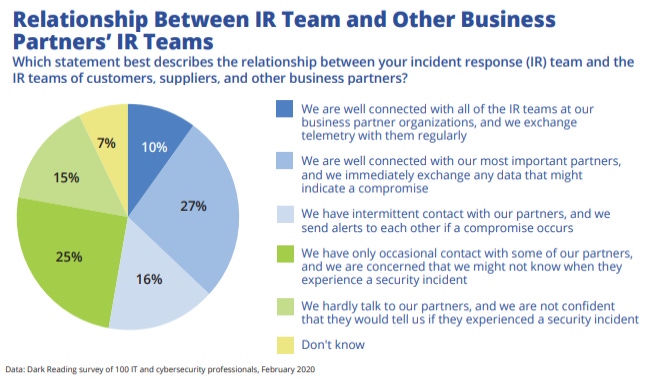
Cybersecurity In-Depth: Digging into data about the latest attacks, threats, and trends using charts and tables.
Only half of respondents to a recent Dark Reading study felt confident that their third-party business partners would, at least, tell them if a compromise occurred.
March 17, 2020

In an interconnected world, incident response is rarely performed in a vacuum. Whether efforts are coordinated with partners, suppliers, customers, or peers, working in concert with other teams can be a huge factor in the success of a particular incident response. In a recent Dark Reading research report we asked cybersecurity professionals how well their IR teams communicated with their partner teams. The results don't indicate catastrophe, but there's still considerable room for improvement.
Just over half of those responding to the survey, 53%, said that they at least communicate with partners if an compromise occurs. Only 10% of professionals said that they have regular communication with partners — the rest leave the communications until there's a likely (or certain) compromise.
That leaves 47% who have no confidence in the effectiveness of their partner communications, particularly when it comes to partners telling them that a compromise has occurred. Aside from the 7% of professionals who are blissfully unaware of the state of partner communications, 40% say that there is some communication — they just worry that it won't be enough to help with the cyber wolves come knocking at their partners' doors.
Download the full research report, The State of Cybersecurity Incident Response, here.
Related content:
About the Author(s)
You May Also Like
The fuel in the new AI race: Data
April 23, 2024Securing Code in the Age of AI
April 24, 2024Beyond Spam Filters and Firewalls: Preventing Business Email Compromises in the Modern Enterprise
April 30, 2024Key Findings from the State of AppSec Report 2024
May 7, 2024Is AI Identifying Threats to Your Network?
May 14, 2024
Black Hat USA - August 3-8 - Learn More
August 3, 2024Cybersecurity's Hottest New Technologies: What You Need To Know
March 21, 2024